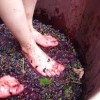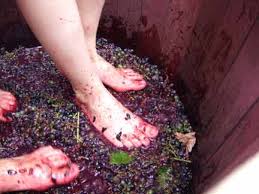Posted on 13 June 2014. Tags: banner ads, banner link advertising, fermentation, fruit, hydrometer, sugar, temperature, text ads, text link advertising, thermometer, winemaking, yeast
As we all know, fermentation is one of the critical stages of winemaking. Without fermentation, it is impossible to create wine. In some cases; however, you may find that you have problems with the fermentation process. Usually, these problems will take the form of either fermentation that just does not occur at all or else is too slow.
One of the reasons that this may occur is that the temperature was either too cold or too hot. Remember that yeast cells are live and in order to become activated they require a temperature that is between 70 and 85 degrees Fahrenheit. Ideally, you should aim for around 72 degrees; however, if you drop below 70 or go above 75 degrees, you will have problems. When the temperature is too cool, the fermentation will likely not occur at all. When the temperature is too warm; however, the yeast can become damaged and will also perform poorly.
This is why it is critical to ensure that you have a stable temperature in the room where you ferment your wine. If the temperature in the room fluctuates, you will generally have problems. Basements tend to make the best places for fermentation; provided the area does not become too cool during the winter. In that case, you can provide a small heat source. Making sure that your fermentation containers are not placed directly on the floor may also help. You can also use a thermometer to monitor the fermentation. A floating thermometer can be placed right in the wine and you can lift it out when you want to check the temperature.
Improperly starting the yeast can also result in problems with fermentation. This is also commonly due to problems with temperatures. Most yeast packets require the yeast to be rehydrated, or moistened, with some warm water prior to use. Ideally, this should not cause any problems. That is, unless the water temperature was too warm. Most yeast packets call for the temperature to be somewhere between 95 and 105 degrees. If the water exceeds these temperature limits even just a small bit, the yeast is likely to be destroyed. As a result, it is unable to support the fermentation process.
As a result, it is important to make sure that you actually verify the temperature of the water before you add the yeast. In addition, it is important to make sure that you do not leave the yeast in the water for too long. Generally, you will need to leave the yeast in the water for about fifteen minutes. If you walk off and forget about the yeast and leave it in the water for even a few minutes longer, you will also run the risk of destroying the yeast cells. Therefore, it is important to keep an eye on the clock and make sure that the yeast does not remain in the water for any longer than 15 minutes at the most.
Adding too much sugar can also cause problems in the fermentation process. Remember that while it is necessary for yeast to have sugar in order to produce alcohol, you can add in too much sugar. When the sugar level is too high, it may begin to have a detrimental effect on the ability of the yeast to produce alcohol. This is why it is critical to verify the amount of sugar that is already present in a batch from the fruit itself before you add in any additional fruit. Remember that the fruit itself will have its own amount of sugar. This level can vary from one fruit to another, making it even more important to verify the sugar content level. A hydrometer can be used for this purpose. If you have not previously used a hydrometer it is a good idea to invest in one and become acquainted with it. A quality hydrometer can help you to avoid many of the problems that might otherwise ruin a good batch of wine.
Posted in Wine 101, Winemaking

Posted on 26 May 2014. Tags: fermentation, filter, grape concentrate, grapes, home wine making, wine, wine making, winemaking

Real Grapes or Grape Concentrate
One of the great advantages of making your own wine is that you are able to take control of as much of the process as you want. If you want to grow and harvest your own grapes or any other kind of fruit and produce wine you can control every aspect of the process. If, on the other hand, you choose to purchase grape concentrate, you can begin making your wine from that point on. Making wine is largely about making a number of different decisions and taking various factors into consideration. Each factor and each decision will have an impact on your final wine.
Grape Clusters or De-Stem
One of the first choices you will need to make if you elect to make grape wine and use fruit in order to do it instead of concentrate is whether you want to de-stem the grapes or use the entire cluster. When making this decision it is important to keep in mind that it really does make a difference. If you decide to use the whole cluster then you will find that your wine has a certain flavor and even nuance that is not present if you de-stem the grapes first. This flavor may or may not be appealing to you. Some people describe it as somewhat ‘green.’ If you like that sort of flavor, then using a whole cluster is an excellent choice. A number of very good, award winning wines are produced using the entire cluster. If; however, you do not think you would like that flavor, then it is best to go ahead and de-stem the grapes before you use them for your wine.
Barrel or Tank Fermentation
Another choice you will have to make is how you want to ferment the must. Yes, there are choices to make here as well. You have two basic choices. You can either ferment in a barrel or a tank. Most winemakers prefer to ferment using a tank. This gives you greater control over the process because the sleeves on the tank give you the option to either heat or cool the must. For example, in the beginning of the fermentation process you may wish to ensure the tanks are cool in order to extract the color from the grape skins. This can also help to stabilize the wine. Of course, you can also choose to ferment your wine in a barrel. This is a popular method when producing white wines because it tends to give them some character that might not be possible from tank fermentation. In the end, it is really up to you and your personal choice, but you will need to make this decision before you produce your first batch of wine.
Yeast Choices
You will also need to give some thought to the types of yeast that you wish to use. Most beginning winemakers are not aware of the fact that grapes picked straight from the vineyard actually have yeast on them. These are naturally occurring yeasts. As a result, you may choose not to add any additional yeast to the fermentation mix. In this case, you can allow the natural or native yeasts to work on their own. The one downside to this problem is that you may run into a problem known as a stuck fermentation. This is when the yeast reaches a certain point and then it just simply stops. Generally, yeasts that are created in the lab will be more stable. Of course, there is a downside to this as well. Many winemakers feel that lab created yeasts are lacking in flavor when compared to natural yeasts.
If you do choose to use natural yeasts, you will need to be prepared to handle a stuck fermentation in the event that it does occur. Adding a yeast nutrient or energizer can often help to combat this problem by providing the natural yeasts the ‘kick’ they need to finish the fermentation process.
Filter or Not to Filter
Finally, you will need to give some thought to whether you wish to filter or not filter your wine. There is no set rule regarding this matter. You may find that a wine that has been unfiltered will have a great amount of richness; however, do be aware that there are bacterial issues which may arise if you choose not to filter your wine. In addition, wines that have not been filtered tend to have a cloudier appearance than those that have been filtered.
Posted in Winemaking

Posted on 25 January 2014. Tags: equipment, wine kits, wine making, winemaking

Making wine from home can sometimes be a costly process to start and it may take quite a bit of your time and effort to make a decent batch. Understanding the proper procedure and what to expect along the way can help you start the process off correctly and save you a lot of trial and error.
Equipment
Get everything you’re going to need before you begin to avoid having to halt your wine making process and search for an additional piece of equipment you may have forgotten. To begin the process you’ll need a fermenting vat to ferment your grapes in. You’ll need to have bottles, corks, and labels ready once your wine is complete in order to prepare it for storage.
Depending on the process you’ll be using you may need oak casks for aging, glass jugs, a hydrometer, a fermentation lock, crushing gates, and an acid titration kit. Wine kits can be purchased that will provide everything you’ll need including chemicals and additional supplies. Some companies will even provide instructions or lessons on the wine making process if you need it.
Ingredients
The main thing you’re going to need for making wine is the grapes or any other fruits you plan on using. It takes about 70 pounds of grapes to make 6 gallons of wine, and you’ll want to make sure you know what type of wine you can make out of the grape varietal you chose. Fruit concentrates can also be used which may be easier than crushing your own grapes, but you may have less control over the end product with this option. If you have the proper space and live in an appropriate region, you may choose to even grow your own grapes.
Sugar, yeast, and additional chemicals will also be required for the process. You’ll need Campden tablets, which are a sulphur-based brewing product, to add to your wine while it is being made. These tablets kill certain bacteria and prevent the growth of wild yeast.
Procedure
The grapes are crushed to form a must for red wines, or the juice is extracted from t he skins and seeds to use for whites. The must or grape juice is fermented in a vat for usually around a week or two then racked to remove sediment. The racking process may be repeated a multiple times depending on the amount of sediment left behind or the type of wine you’re making.
Once the wine is siphoned out of the vat and the additional sediment is left behind it can be bottled and will be ready for storage. Knowing how long you’ll be aging the wine you’ve produced will allow you to prepare an appropriate storage area in advance. Some types may be ready for consumption immediately while others may require months or years of aging.
For any new wine makers, errors can be expected regardless of how prepared you are. Once you’ve made a few batches you’ll likely begin to better understand the process and be more confident in your brewing abilities. For anyone with a love of wine this can be a fun and rewarding hobby and for some it can even turn into a lucrative business.
Posted in Featured Articles, Winemaking

Posted on 21 January 2014. Tags: home wine making, winemaking
Posted in Wine Videos

Posted on 20 January 2014. Tags: home wine making, winemaking
Posted in Wine Videos








